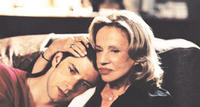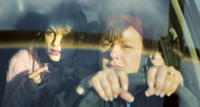
 It is an unfortunate reality of this film festival (and a justifiable criticism of it) that the weakest films are programmed generally toward the end. This is partly just the politics of the film festival circuit: because industry professionals flock to the opening weekend, often directly from Venice, most are gone by the end of the week, either on to places like San Sebastien, or taking a short break before New York. As a result, the last few days become a crap shoot and even the most promissing names, performers and filmmakers can turn up empty.
It is an unfortunate reality of this film festival (and a justifiable criticism of it) that the weakest films are programmed generally toward the end. This is partly just the politics of the film festival circuit: because industry professionals flock to the opening weekend, often directly from Venice, most are gone by the end of the week, either on to places like San Sebastien, or taking a short break before New York. As a result, the last few days become a crap shoot and even the most promissing names, performers and filmmakers can turn up empty.In the serene column are three films: Francois Ozon’s Le Temps qui Reste, Mohammad Rasoulof’s Iron Island and Amos Gitai’s Free Zone. The three best films of the last three days, they represent a wide range of narrative and visual style by two established masters and one impressive emerging artist.
 No strangers to the film festival are both Francois Ozon and Amos Gitai. Ozon’s colourful and highly idiosyncratic personal films have been popular entries in recent festivals, ranging from the crazy vamping of 8 Femmes to last year’s dramatically intense 5 x 2. In Le Temps Qui Reste, a young man diagnosed with cancer faces off against the unresolved relationships of his life and tries to settle scores before his time is up - all without telling anyone except his grandmother what is going on. Scenes of hot intensity are contrasted with longer, more deeply considered
No strangers to the film festival are both Francois Ozon and Amos Gitai. Ozon’s colourful and highly idiosyncratic personal films have been popular entries in recent festivals, ranging from the crazy vamping of 8 Femmes to last year’s dramatically intense 5 x 2. In Le Temps Qui Reste, a young man diagnosed with cancer faces off against the unresolved relationships of his life and tries to settle scores before his time is up - all without telling anyone except his grandmother what is going on. Scenes of hot intensity are contrasted with longer, more deeply consideredreflective moments as the character reckons who he has been and tries to make good. Jeanne Moreau is particularly moving in a brief appearance as his only confessor. His contact with her marks the beginning of his motivated change to be remembered as someone else. Painfully realistic, it offers no easy conclusions or happy endings, though the character is eminently more likeable before he dies.
 Amos Gitai’s Free Zone is the second in his trilogy that began with last year’s Promised Land and continues his exploration of lives which occur outside definable Middle Eastern states, and are also caught within their politics. In this film, Natalie Portman plays an American Jewish woman whose life circumstances put her in a car driven by an Israeli woman bent on repayment of a debt owed to her family by a Palestinian ex-pat known as “the American” living in Jordan with another Palestinian refugee woman. Don’t worry if you didn’t keep track of that. Neither did I. It doesn’t matter. The point is that all three women are powerful actresses whose characters are caught literally in a world between all borders, known as the Free Zone. They are unable to move and so are driven inward to their own personal grievances with each other. These characters drive and drive but don’t get anywhere, dancing between Jordan, Israel and Syria. They are doomed to drive in circles and search in vain for meaning. Not hard to see the symbolism there!
Amos Gitai’s Free Zone is the second in his trilogy that began with last year’s Promised Land and continues his exploration of lives which occur outside definable Middle Eastern states, and are also caught within their politics. In this film, Natalie Portman plays an American Jewish woman whose life circumstances put her in a car driven by an Israeli woman bent on repayment of a debt owed to her family by a Palestinian ex-pat known as “the American” living in Jordan with another Palestinian refugee woman. Don’t worry if you didn’t keep track of that. Neither did I. It doesn’t matter. The point is that all three women are powerful actresses whose characters are caught literally in a world between all borders, known as the Free Zone. They are unable to move and so are driven inward to their own personal grievances with each other. These characters drive and drive but don’t get anywhere, dancing between Jordan, Israel and Syria. They are doomed to drive in circles and search in vain for meaning. Not hard to see the symbolism there! Mohammad Rosoullof’s exquisite Iron Island is a beautifully conceived, serene description of a made up world that is entirely plausible (one of the first questions in the post-screening Q and A was “did this really happen?”). An entrepreneurial man with a good heart establishes a small colony (essentially a village) on an abandoned oil tanker off Iran’s coast, accessible only by motorboat and an automatic lift. It is a world unto itself, where goats for a wedding are temporarily housed in the school and where love is just as forbidden among inappropriate lovers, as it is on dry land. In one of the movies most impactful scenes, a smitten young man passes to his lover on a rope through a porthole from above, his most prize belongings, while she passes back her chador mask and a bracelet. He in return sends down his shirt. The striptease can only go so far of course, before reality hits - they cannot physically send themselves. Filled with beautiful supporting characters created in simple brushstrokes, and a euphoric sequence in which boys jump off the ship after yellow barrels of oils to push them to shore, the film lives up to the fable like quality of Iranian cinema at its best - where everything is allegory and the grittiest realism has a magical quality to it.
Mohammad Rosoullof’s exquisite Iron Island is a beautifully conceived, serene description of a made up world that is entirely plausible (one of the first questions in the post-screening Q and A was “did this really happen?”). An entrepreneurial man with a good heart establishes a small colony (essentially a village) on an abandoned oil tanker off Iran’s coast, accessible only by motorboat and an automatic lift. It is a world unto itself, where goats for a wedding are temporarily housed in the school and where love is just as forbidden among inappropriate lovers, as it is on dry land. In one of the movies most impactful scenes, a smitten young man passes to his lover on a rope through a porthole from above, his most prize belongings, while she passes back her chador mask and a bracelet. He in return sends down his shirt. The striptease can only go so far of course, before reality hits - they cannot physically send themselves. Filled with beautiful supporting characters created in simple brushstrokes, and a euphoric sequence in which boys jump off the ship after yellow barrels of oils to push them to shore, the film lives up to the fable like quality of Iranian cinema at its best - where everything is allegory and the grittiest realism has a magical quality to it.
No comments:
Post a Comment